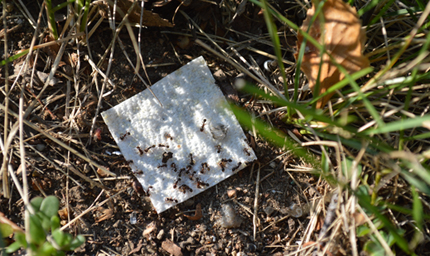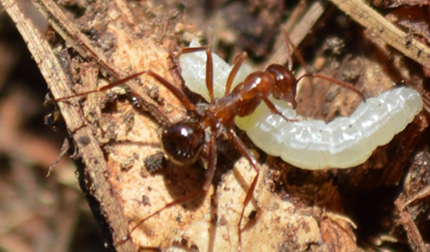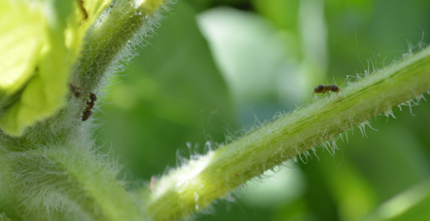5585 Guilford Road • Madison, WI 53711-5801 • 608-273-8080 • Fax 608-273-2021
www.agronomy.org
Twitter | Facebook
NEWS RELEASE
Contact: Hanna Jeske, Associate Director of Marketing and Brand Strategy, 608-268-3972, hjeske@sciencesocieties.org
Advocating for ant antics
Apr. 12, 2017 - You’re not the only one working hard in your garden or field. The ants who live in the soil are quite the farmers, too. They dig tunnels that provide holes for air and water. They produce organic matter similar to the compost you add. And all for free
 Naim Edwards investigated the benefits of ants in urban gardens. “We should be grateful for ants because they are the garbage collectors of the soil,” Edwards says. “Ant colonies in a 30 square foot space can turn over 80 pounds of soil a year - often more than earthworms (depending on the population).”
Naim Edwards investigated the benefits of ants in urban gardens. “We should be grateful for ants because they are the garbage collectors of the soil,” Edwards says. “Ant colonies in a 30 square foot space can turn over 80 pounds of soil a year - often more than earthworms (depending on the population).”
All this collecting and turning over means more underground passageways for plant roots. Additionally, ants who nest in the ground break down organic matter—dead leaves, stems, roots, or food scraps—and improve the soil’s quality. The soil is richer and looser. Water soaks in better.
Ants are part of the ecosystem that makes a garden happen. Edwards compares it to the behind-the-scenes work our bodies do to function every day. Fighting viruses, digesting food, and pumping oxygen are all jobs our bodies perform without our conscious direction. “A garden is the same way. The basic gardener may seed, transplant, water, and weed, while insects are pollinating and eating, worms are tunneling through the soil, and plants are turning sunlight and carbon dioxide into biomass. There's a lot going on.”
But just one type of ant may not be enough. “Species diversity is key,” Edwards asserts. “Ants of different species are most active at different times of day, so if you have a variety of species, you likely get around-the-clock soil maintenance and pest control.”
 Although Edwards’ research team expected to find ten or fewer ant species in the sampled garden plots, they found as many as 21 unique species during the study! Gardens with the highest species diversity were typically adjacent to lawn or wooded areas. They offered a more diverse environment and better access to resources for the ants.
Although Edwards’ research team expected to find ten or fewer ant species in the sampled garden plots, they found as many as 21 unique species during the study! Gardens with the highest species diversity were typically adjacent to lawn or wooded areas. They offered a more diverse environment and better access to resources for the ants.
A healthy ecosystem means more than just ants. “If you have a garden with 21 ant species, that garden probably has honey bees, monarch butterflies, bird diversity, and healthy vegetables! Often in ecology, the more species the better and more resilient the system,” Edwards explains.
More ants can also mean fewer pests. Edwards observed which ant species ate different life stages of squash bugs and cabbage looper moths. Different ant species seemed to dine on specific meals. This depended on the size of the ant, resistance of the prey, and the time of day each was active. Also, if one ant species dominated the soil surface, other ants were more likely to search for food and prey on plants.
“One little ant might spend up to ten minutes or more trying to pull an insect egg off of a leaf. Imagine if 100 ants or a 1000 spent the whole day trying to remove eggs; that's some serious pest control,” Edwards declares.
Edwards found the number of ant species depended on how friendly the garden habitat was for them. Two of the garden plots with heavy clay soils had no ants observed from May through August. Heavy clay soils are most likely too difficult a habitat for ants to make their home. Garden sites bordered by pavement also had fewer ant species present. These sites had less leaf litter, rotting logs, and dead branches for the ants to use for their nests. These features are attractive to ants, because they provide food, nesting sites, and a cooler soil.
 Finally, intense tilling with tractors greatly affected the ant communities. “Gardens that were tractor-tilled in the spring showed no signs of ant activity until June--nearly 4 weeks after tilling,” Edwards observed. The tractor activity likely damaged the nests and tunnels, and scattered food and water resources the ants need to survive.
Finally, intense tilling with tractors greatly affected the ant communities. “Gardens that were tractor-tilled in the spring showed no signs of ant activity until June--nearly 4 weeks after tilling,” Edwards observed. The tractor activity likely damaged the nests and tunnels, and scattered food and water resources the ants need to survive.
Gardeners—and, on a larger scale, farmers--should encourage more of these hard-working helpers, Edwards says. “Gardens that are managed in ways that attract and support beneficial insects will be more resilient and easier to manage in the long term. I would prefer if people gardened from the holistic standpoint of, ‘This garden is not just for vegetable production, but a sanctuary for biodiversity.’ Without being mindful of how ants, bees, butterflies, earthworms, and other organisms contribute to healthy soil and plants, we compromise the plants' ability to grow. And we often require more work, time, and inputs from ourselves, when nature is ready and willing to help and serve us.”
At the time of the study, Edwards was pursuing his degree at the University of Michigan. He is now the garden designer and program manager at Voices for Earth Justice in Detroit.
Read more about Edwards’ research in Urban Agriculture and Regional Food Systems.
Urban Agriculture & Regional Food Systems is a multi-disciplinary gold open access journal that focuses on urban and peri-urban agriculture and systems of urban and regional food provisioning in developing, transition, and advanced economies.